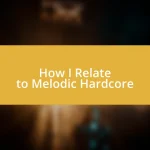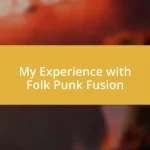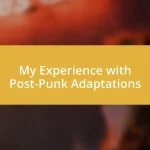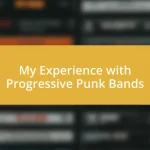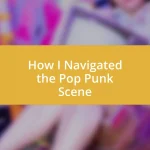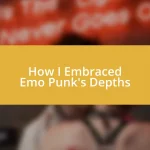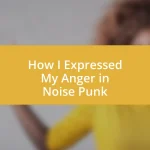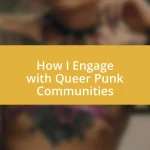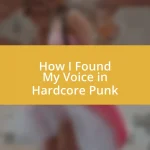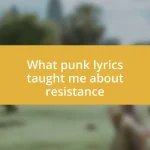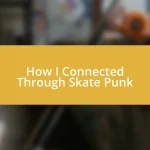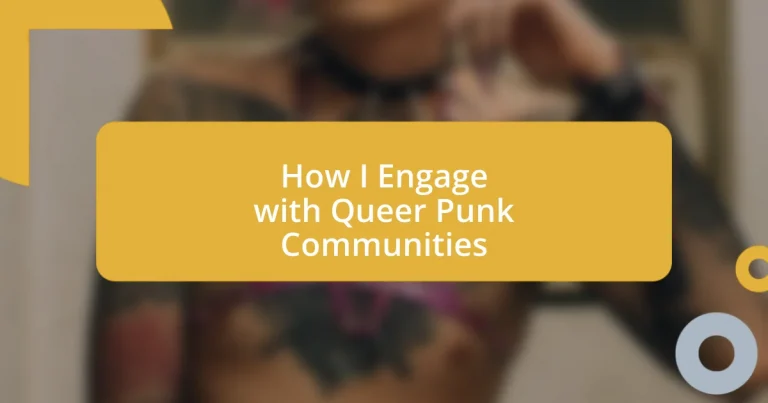Key takeaways:
- Queer punk culture serves as a safe haven for self-expression, blending music with activism and community connection.
- Engaging with local queer punk communities through events, zine creation, and supporting musicians fosters relationships and amplifies marginalized voices.
- Building enduring connections often arises from shared experiences and ongoing dialogue, which nurtures a supportive network within the queer punk scene.
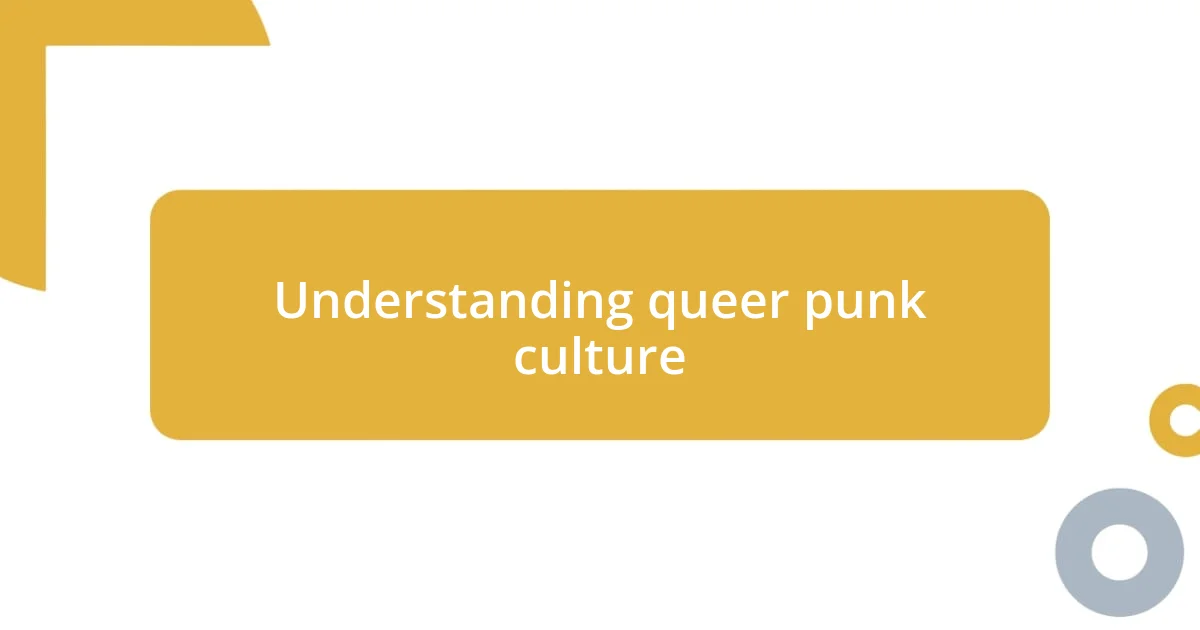
Understanding queer punk culture
Queer punk culture is a vibrant mix of rebellion, artistry, and identity exploration. I remember attending a small basement show where the energy pulsed like a heartbeat, and the atmosphere buzzed with acceptance and defiance. It struck me how these spaces not only showcase music but also serve as safe havens for individuals to express their true selves, free from societal norms.
At its core, queer punk challenges the status quo and amplifies marginalized voices. I often think about how the DIY ethic of punk resonates deeply within the queer community — it’s about creating something authentic from scratch. Have you ever felt that spark of empowerment when you’ve taken control of your narrative? It’s exhilarating, and that sense of autonomy breathes life into the culture.
What I find most captivating is how queer punk intertwines personal and political expression. At one show, I saw a band perform a song that spoke directly to the struggles of LGBTQ+ individuals, and the raw emotion in their lyrics left me in tears. It made me realize that this culture is not just about music; it’s about storytelling, activism, and forging connections among a community that thrives on authenticity and unapologetic self-expression.
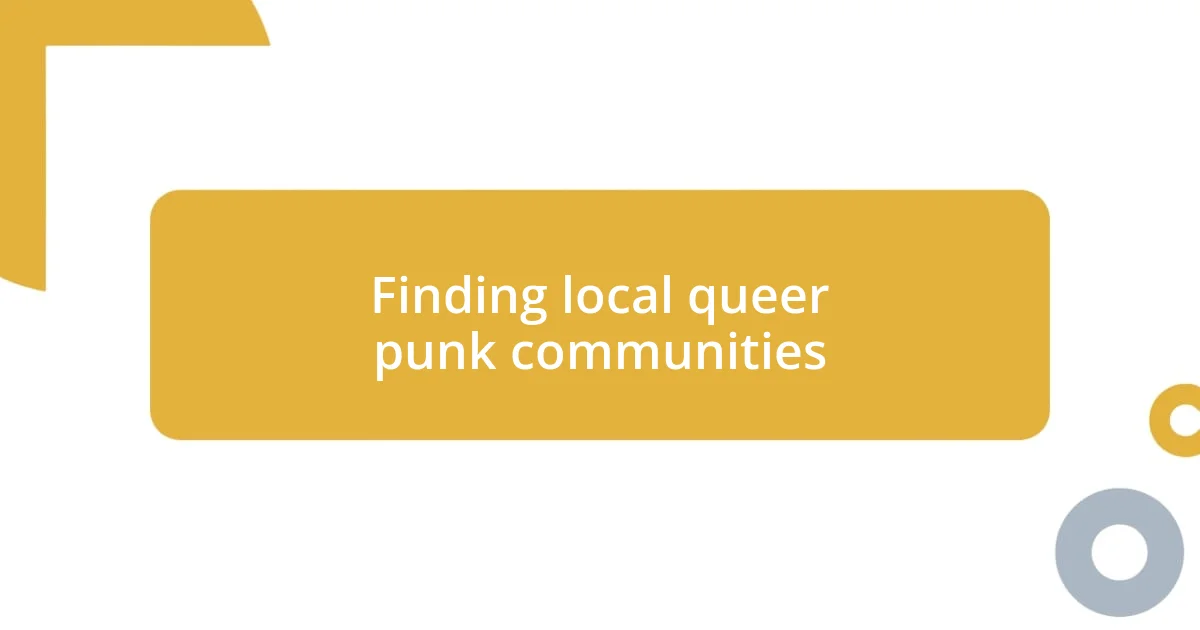
Finding local queer punk communities
Finding local queer punk communities can be an exhilarating adventure. I remember the thrill of scouring social media platforms for local shows, joining LGBTQ+ forums, and discovering collectives that celebrated my identity while blasting punk music. Connecting with others who share my passions often led me to tucked-away venues and unexpected gigs that felt like a homecoming.
To find these vibrant local spaces, try the following:
- Explore local LGBTQ+ and punk event pages on social media.
- Attend pride events or fests that feature punk bands; you never know who you’ll meet.
- Check out community boards at coffee shops or libraries for zines and flyers about punk gigs.
- Join online forums or group chats specifically geared towards queer punk lovers in your area.
- Visit record stores and ask staff for local bands and venues that support the queer punk scene.
Every encounter has the potential to open doors that lead to spirited conversations, unforgettable performances, and maybe even lifelong friendships. It feels like stepping into a tapestry of shared experiences, each thread woven from the resolve to uplift queer voices within the punk sphere.
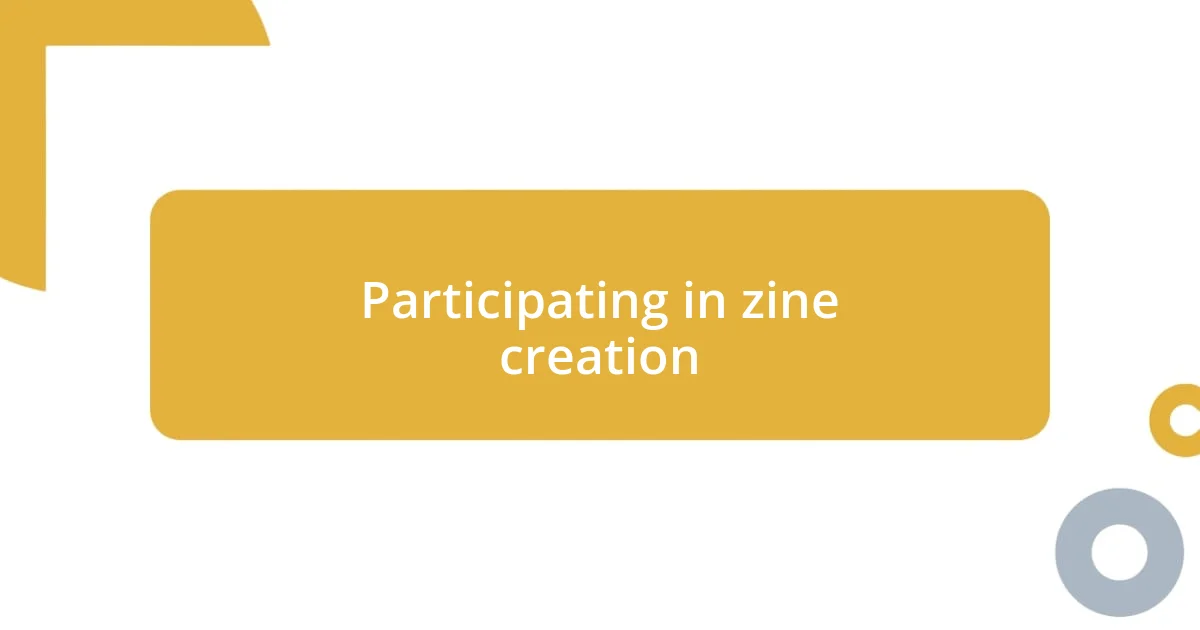
Participating in zine creation
Participating in zine creation is a thrilling way to express oneself within the queer punk community. I recall the first time I sat down with friends to create a zine — the excitement was palpable. We poured our thoughts, struggles, and artwork onto the pages, each contribution a testament to our shared journey. Zines offer a unique, accessible way to communicate our stories, and I often feel empowered flipping through the pages filled with raw, unfiltered creativity.
Crafting a zine goes beyond just putting words on paper; it’s about creating a platform for marginalized voices. I remember a moment when a friend’s piece about their experiences with identity sparked a deep discussion among our group. That exchange was not only enlightening but showcased the transformative power of sharing our narratives. In essence, zines become more than just printed pages; they evolve into a communal reflection of identity, resistance, and creativity.
When I think about the zine community, I’m reminded of the countless nights spent trading our creations at local punk shows. It was a beautiful way to build connections with others. Every zine resonated with its own rhythm, echoing our varied experiences, joys, and struggles. I can’t help but smile remembering those moments, where we connected through paper, ink, and passion, sharing in this vibrant tapestry of queer punk culture.
| Aspect | Description |
|---|---|
| Creative Expression | Zines allow for raw and personal storytelling, letting individuals express their unique experiences. |
| Community Building | Creating zines fosters connections among queer punk enthusiasts, encouraging open dialogues and shared experiences. |
| Accessibility | Zines are an affordable medium, making it easy for anyone to share their voice and art without the constraints of mainstream publishing. |
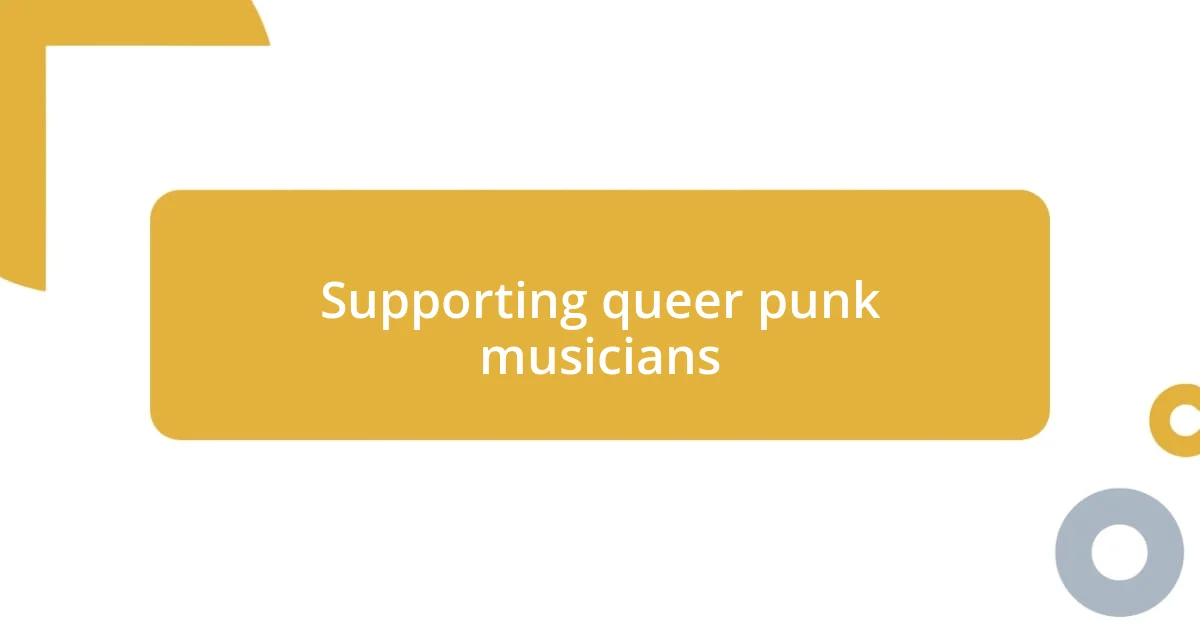
Supporting queer punk musicians
Supporting queer punk musicians is one of the most rewarding ways I engage with this vibrant community. I recall attending a local show where the headlining band was a group of queer musicians sharing their stories through their music. I felt a rush of pride as I danced along, knowing that every chord was a celebration of our identities. Aren’t those connections unique? They remind me that punk isn’t just music; it’s a powerful vehicle for representation and resilience.
Buying merch directly from queer artists has become a ritual for me. I love walking away with a shirt or vinyl that not only supports their craft but also serves as a conversation starter. I once bought a patch from a band that spoke about their journey with mental health in their lyrics. I wore it proudly, leading to a deep conversation with a stranger at another show about the importance of mental health within the punk scene. Isn’t it fascinating how a simple item can foster dialogue and create solidarity?
Moreover, I’ve noticed that sharing their music on social media amplifies their voices beyond just the local scene. I often curate playlists featuring queer punk bands, encouraging others to discover new artists. I remember the joy when a friend told me they found their new favorite band through one of my playlists. In that moment, I realized that supporting queer musicians isn’t just about attendance—it’s about creating spaces where their art can thrive, resonate, and ultimately shine.
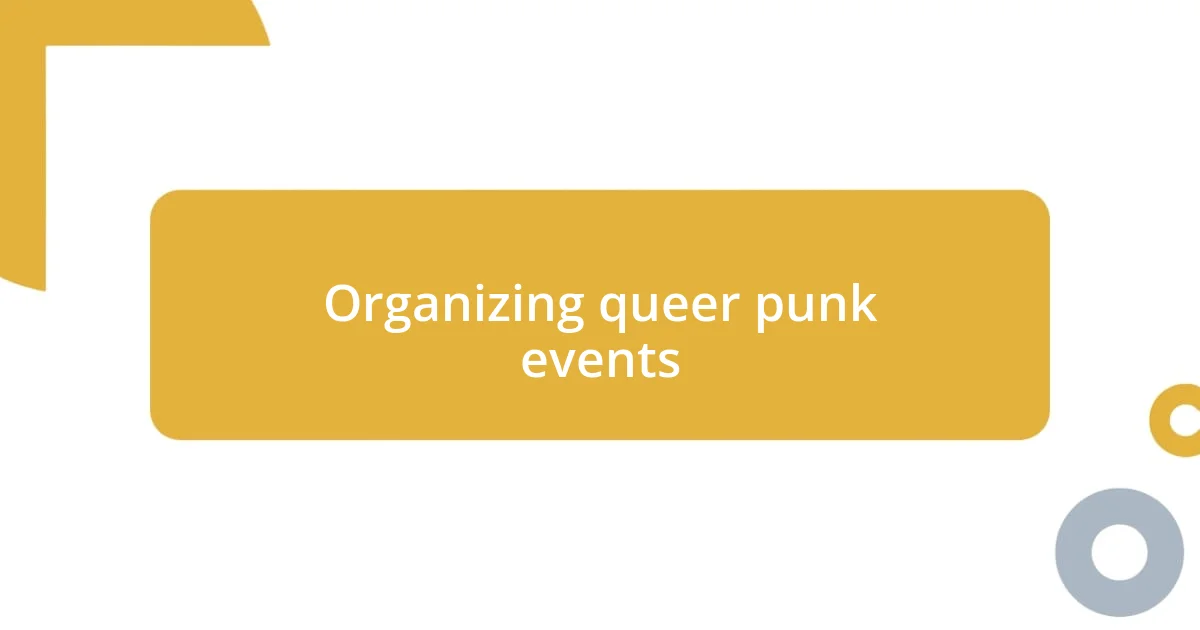
Organizing queer punk events
Organizing queer punk events has been one of the most fulfilling experiences in my journey through this community. I remember the nerves I felt the first time I coordinated a small local show—would people come? But as I watched the crowd pour in, all adorned in vibrant attire, I felt an overwhelming sense of connection and acceptance wash over me. Those moments remind me why creating these spaces is crucial; they become sanctuaries where everyone can feel seen and celebrated.
To make each event impactful, I’ve learned the importance of collaborating with diverse local artists, promoting not only queer talent but also ensuring accessibility for all attendees. At one particular gig, I partnered with a trans artist for live art while the bands played. During that night, I saw attendees transfixed by the fusion of sound and image, truly embodying the spirit of punk. How beautiful is it when creativity intersects? It enriches our experience and fosters a collective energy that transforms an ordinary night out into something magical.
What I’ve also noticed is that the process itself can be a form of activism. Each time I engage with local businesses to sponsor events or make space for marginalized voices, I see the ripples of change. I vividly recall one event where the conversation shifted to mental health and how that impacts our community. Attendees shared their stories, laughter blended with tears, and it felt as though we were not just creating an event, but rather a movement. Connecting through punk extends beyond music—it’s about crafting a culture of inclusivity, resilience, and fierce authenticity.
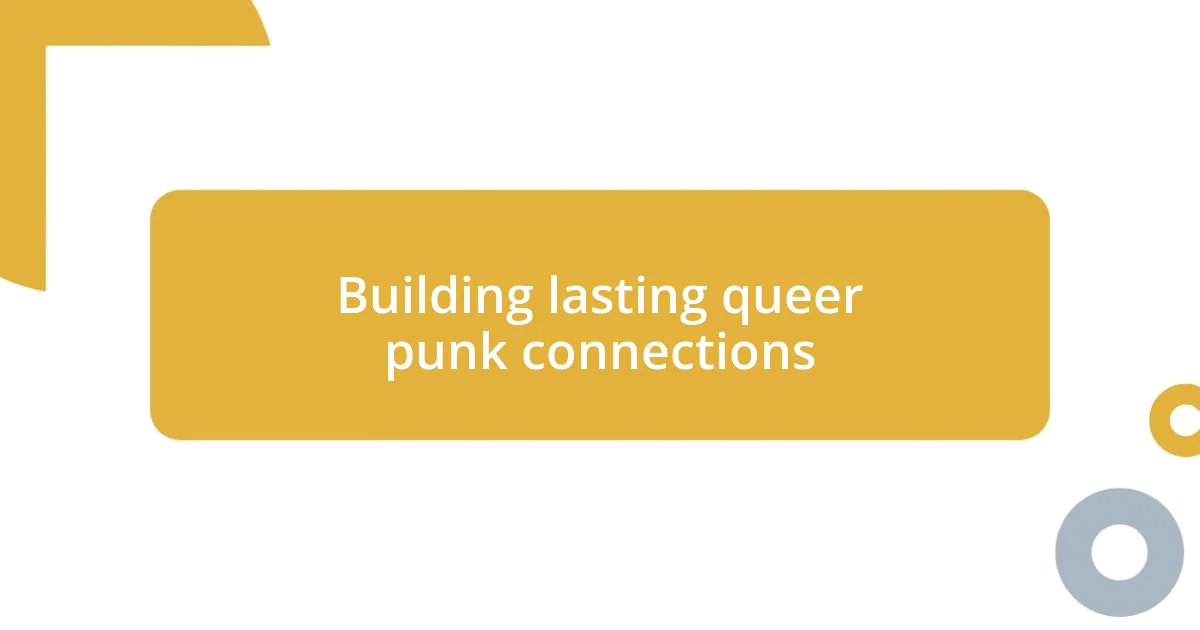
Building lasting queer punk connections
Building lasting queer punk connections often starts with genuine dialogue and shared experiences. I remember striking up a conversation with someone during a post-show gathering, both of us drawn together by our shared love for a band that tackled LGBTQ+ issues in their lyrics. We exchanged stories about how punk shaped our identities, revealing pieces of ourselves that, for years, felt tucked away. Isn’t it incredible how a shared passion can create bonds that feel almost instantaneous?
Another memorable experience was when I hosted a DIY punk art workshop. It was meant to be a fun, light-hearted event, but it quickly morphed into a safe space for everyone to share their struggles and triumphs. As I watched attendees open up while painting, I realized that connecting over creativity, especially within the punk scene, offers a unique platform for healing. How often do you find an opportunity to express yourself freely alongside those who truly understand your journey?
I’ve also found that following up after events can solidify these connections. I make it a point to reach out, whether through social media or text, to check in or share new music I’ve discovered. There was a time when I dropped a message to someone I had met at a show months prior. They replied excitedly, sharing that my message uplifted them during a tough time. Moments like these illustrate that building relationships within queer punk isn’t just about the immediate shared experience, but about nurturing those connections over time. It’s this ongoing dialogue that transforms acquaintances into lifelong allies.
